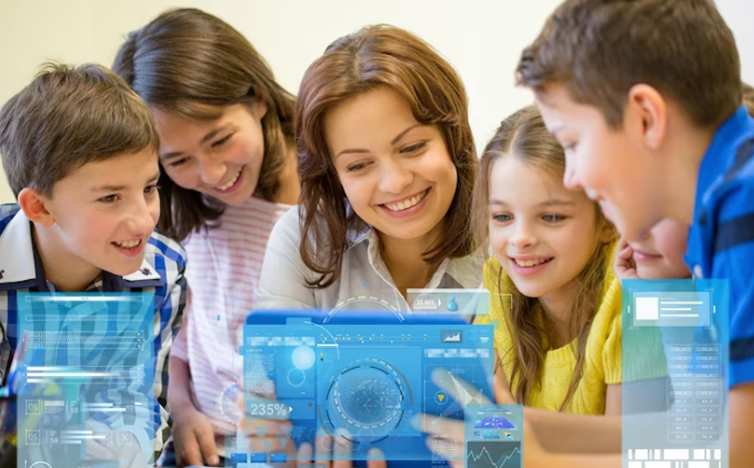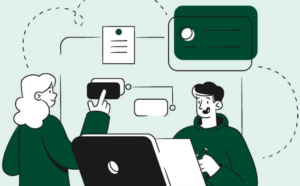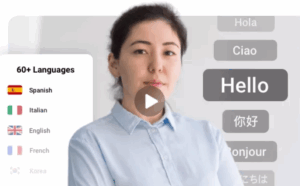In the vast world of education, there’s a new spark of excitement: Artificial Intelligence (AI) tools. Imagine classrooms buzzing with curiosity, where every student feels inspired and understood. AI isn’t just about technology; it’s about unlocking the magic of learning. As we dive into this adventure, we’re asking a big question: How can I make learning even more amazing? This article dives deep into the heart of that question, exploring how AI can add a sprinkle of wonder and joy to education, making every lesson a journey of discovery and every student’s dream a little closer to reality.
Table of Contents
Personalized Learning with AI

Personalized learning is like having a customized learning experience designed just for you. Instead of everyone following the same lesson plan, personalized learning adapts to your unique needs and preferences. It’s like having a teacher who understands how you learn best and tailors the lessons accordingly.
How AI Analyzes Individual Learning Patterns:
“Personalized Learning with AI” is like having a teacher who knows you really well, almost like a friend who understands exactly what you need to learn and how you learn best. It’s about using cool technology called Artificial Intelligence (AI) to make your learning experience feel tailor-made just for you. So, instead of everyone learning the same way, AI helps customize your lessons, making them more exciting, easier to understand, and just right for your unique style of learning. It’s like having a magical learning buddy who helps you shine brighter in school!
How Personalized Learning Helps Improve Students’ Results:
Personalized learning has several advantages. Since the education is customized to suit your needs, it often leads to better understanding and retention of information. It keeps you engaged because you’re learning at a pace that suits you. As a result, personalized learning with AI has the potential to improve overall student outcomes, making education more effective and enjoyable.
Smart Learning Platforms:
Smart learning platforms that use AI are changing how we learn in a big way. Imagine this: the platform looks at what you understand and what’s a bit tricky for you in real-time. Then, it changes the lessons to fit you better. If you’re finding something hard, it gives you extra help. If you’re finding it easy, it moves you ahead to keep things interesting. So, whether you’re struggling or excelling, these platforms make sure you’re getting just the right level of challenge and support.
Intelligent Tutoring Systems
Say goodbye to the old way of tutoring! Now, we have smart tutoring systems that use AI. These systems act like your personal tutor, giving you instant help and feedback. They’re like having someone guide you one-on-one. These systems not only help you solve problems but also change the way they teach based on how fast or slow you learn. This makes learning more fun and customized, just for you.
Automated Grading and Feedback:
Grading papers and tests used to take a lot of time, but now, thanks to AI, things are changing. Automatic grading systems not only help teachers save time but also give students feedback quickly and consistently. This speeds up how fast students learn, and it lets teachers spend more time improving how they teach.
Language Learning Applications:
“Language Learning Applications of AI” is like having a super helpful friend who knows all about languages and how to teach them in a fun way. These apps use something called Artificial Intelligence (AI) to make learning languages really easy and enjoyable. It’s like having a personal language coach who understands how you learn best and can give you just the right practice and tips. With AI, learning languages feels like an exciting journey where you can explore new words, cultures, and skills. It’s not just about learning a language; it’s about discovering a whole new world of possibilities and connections!
Virtual Reality (VR) and Augmented Reality (AR)
Virtual Reality (VR) and Augmented Reality (AR) are like magic glasses for learning.
Virtual Reality (VR):

Imagine putting on special glasses, and suddenly, you’re in a different world. It’s not the real world around you; it’s a computer-made world. In education, VR can take you to historical events, outer space, or even inside the human body, making learning super exciting.
Augmented Reality (AR):

Now, think of AR like having a secret layer on your regular view. When you use AR, you still see the real world, but it adds extra information or fun things to what you’re looking at. It’s like having a helpful guide right in front of you as you explore. In education, AR can make textbooks come to life or show 3D models right on your desk.
So, VR and AR are like awesome tools that use cool technology to make learning an adventure!
Content creation
Content creation by AI is like having a helpful computer program that can write or generate different kinds of stuff. It might be articles, stories, or even poetry! The AI looks at patterns and information it learned, and then it creates something new based on that. It’s a bit like having a smart robot friend who can help with writing tasks, making things quicker and sometimes even more creative!
Automated Administrative Tasks:
Automated administrative tasks mean using smart computer programs to do some of the jobs that people used to do. Instead of humans doing repetitive or routine tasks, the computer does them automatically. It’s like having a helpful robot assistant that can organize schedules, manage records, and handle other office tasks without people having to do them all by hand. This helps things run smoother and frees up time for people to do more interesting or important work.
Predictive Analytics for Early Intervention:
Predictive analytics for early intervention is like having a super-smart friend who can predict things before they happen. In education, it means using clever computer programs to figure out if a student might need some extra help even before they start struggling. These programs look at how students are doing and can suggest ways to support them early on. It’s a bit like having a heads-up to make sure everyone gets the right help at the right time, making learning easier for everyone.
Continuous learning and professional development
Continuous learning and professional development mean always finding ways to get better at your job or learn new things. It’s like saying, “I want to keep growing and getting better at what I do.” So, if you’re a teacher, it could be learning new ways to teach. If you’re a doctor, it might be staying updated on the latest medical techniques. It’s about not stopping your learning journey even after you finish school, and always trying to improve so you can do your job even more awesomely!
Conclusion
Artificial Intelligence (AI) is changing the way we learn and teach. From personalizing lessons for each student to making administrative tasks easier, AI is making education more exciting and effective. It’s like having a smart helper that understands how we learn best. As we move forward, this collaboration between technology and education promises to create a learning environment that is more fun, efficient, and inclusive, preparing students and teachers for whatever comes next. It’s all about making learning a lifelong adventure!
FAQS
In what ways can students utilize AI to boost their learning experience?
Students can use AI for personalized help in learning, interactive apps, and smart study tools, making their learning experience better and customized to how they learn best. AI makes learning more personal and effective for students.
In what ways can AI simplify teaching and increase its impact?
AI can simplify teaching by automating tasks like grading, providing personalized learning plans, and offering insights into student progress. This makes teaching more efficient and impactful by allowing educators to focus on individual student needs and refining their teaching methods.
Can AI offer a more effective and efficient method of teaching students compared to human teachers?
AI can enhance teaching by offering personalized learning, instant feedback, and adaptive content, but it’s not meant to replace human teachers. The combination of AI and human educators can create a more effective and efficient learning experience, catering to individual needs and leveraging the strengths of both AI and human interaction.
Can AI substitute the overall educational experience?
No, AI can’t replace the whole education experience. It can help with some things, but having real teachers and interacting with other students is still really important for a good education.




